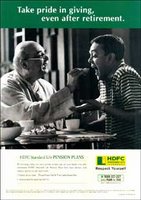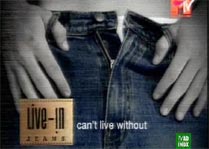Brand: HDFC Standard Life Insurance
Company: HDFC Standard Life Insurance
Agency: Leo Burnett
Brand Count :113
India is one of the most lucrative financial services market in the world. The insurance market in India is estimated to be around 400 bn growing at an astounding rate of 30% p.a. Still the experts believe that the potential is largely untapped.

The insurance market is dominated by the public sector giant LIC with a market share of around 71.4%. With the private players leading the growth story, this sector is witnessing more marketing actions than even the FMCG sector.
Traditionally insurance are sold through direct selling. The reason being purely the nature of product warrants direct communication with the consumer. Kotler categorizes Insurance as an "Unsought" product . Unsought products are those which are ranked lowest in terms of consumer interest. Consumers may not be even aware of either the need or existence of such products.
Historically, Indian insurance products are sold for wrong reasons. People buy insurance to avail the tax benefit and not to ensure protection and LIC was happy to oblige. Hence most of the sales talks start with the question " How much do you pay tax?" . Little money was spent on brand building because there was no competition for LIC.
Things have now changed. With the increasing financial literacy, volatile economy and uncertain future a

re prompting Indians to look seriously at insurance as a means for protection rather than tax saving instrument. With more private players entering the domain, the issues of differentiation and branding became important.
HDFC Standard Life Insurance (HDFCSL) is one of the major players in the insurance market. One of the first private insurers to enter the market, HDFC SL entered the scene in 2000. It is a joint venture between the housing finance major HDFC and the UK insurance giant Standard Life.
Now a days we are seeing a lot of media action from this company. Although a slow starter HDFC SL was having a small share of the pie. It was eclipsed by ICICI prudential with its media and sales blitz making it second largest player in the Insurance market. 2006 saw a shake up in this market with Bajaj Allianz edging out ICICI from the second spot . Bajaj have a market share of around 8% and HDFC SL and ICICI fighting at 3rd place with around 7.5%.
HDFC is currently focusing on The Pension Plan and the Child Plan aiming to cash in on the potential of these segments. The pension market in India is estimated to be around 1000 crore with a huge potential for growth in the future.
The change in the demographics is going to drive the pension market in India. Traditionally in a Joint family, there was an inherent protection for elders. With the urbanisation and the evolution of Nuclear Urban Family ( NUF) , elders are often forgotten. Out of the 314 mn workers in India only 11% has some sort of old age security. People earlier depend on social security products like EPF and PPF to build a corpus for their golden years.
It is this potential that has encouraged HDFC to promote its pension plans. Introduced in 2002, this product has been well received by the consumers. The ads are well executed and revolve around the positioning of "Respect Yourself". The target segment being the 30 year old family man. The basic theme of the campaign is to appeal to the self respect of these men who are in their prime of their career. "Even after retirement let your hands give rather than receive" is one of the best themes for a pension plan. Since I am in that category , these ads strike a chord in me and reminds me of the need to plan for my retirement. The same theme is carried to the Child plan also.
Although these campaigns will help to invoke an interest in TG, the market is in its nascent stage and lot of convincing has to be done to crack this huge market. One of the stumbling block being the expensive annuity plans. For example , it takes a 2 lakh corpus to generate Rs 1000 per month pension. Also if you put 10000 per month in a pension plan if you are 30 yrs old, what you will get after 20 years is a monthly pension of 10000. ( correct me if I am wrong). So it looks unattractive in the first look compared to MFs.
HDFC Standard Life has correctly identified the pulse of the target market and is all set to reap the benefits.
Source: Businessline, HDFC SL website, indiainfoline.com, agencyfaqs
 he brand was nationally launched this year. Also came in to the market Sparsh Baby soap posing a direct competition to the market leader J&J.
he brand was nationally launched this year. Also came in to the market Sparsh Baby soap posing a direct competition to the market leader J&J.





